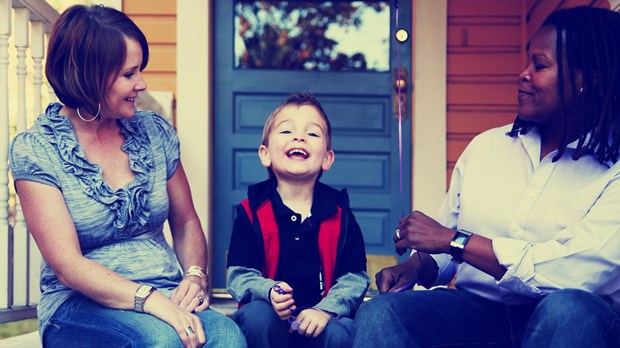Imago Gay

I am frequently asked by sincere Christians how they can “reach out” and love their gay neighbors, friends, and colleagues—as if there is some sort of trick or special way of doing it. It’s like a person’s sexual orientation automatically qualifies them for a special category all of their own and therefore some special type of love is required. Yet there is nothing fundamentally different between a gay and a straight person, certainly nothing that requires a different genre of love. There ought to be no essential difference in how we treat anyone (in the faith or without).
You Are My Neighbor?
When we begin to categorize people and push them into the “different” box, we inevitably push them further away from the obligation of neighborliness all disciples of Jesus are called to show. Remember Jesus’ take on the question “Who is my neighbor?” (Luke 10:25–37). Disciples are to understand themselves through the lens of the neighborliness exercised by the Good Samaritan and not the religious folk in the parable. Those of us who have gay friends, family, or the like, already know that the homosexually oriented person is our neighbor—they always were—the rest of us just need to catch up.
Nonetheless we must admit that differences do remain; otherwise we wouldn’t find it so hard, right? There are cultural disparities that we need to be aware of, so sensitivity does need to be cultivated. This is not dissimilar to learning to love someone from another culture, socioeconomic background, age, gender, and the like. In order to communicate lovingly we need to appreciate this, or we risk our love not being received in the way we intended.
When it comes to our gay neighbors, it is important to acknowledge the existing history between the church and LGBT community, and the stance many in the church have adopted toward them. We would be naïve to think that we get to start with a blank slate. It will come as no surprise that there is a lot of very bad history between these two communities, resulting in a great deal of alienation—so much so that when two individuals from either community seek to engage even in friendly neighborly dialogue, it can end up being clumsy at the very least.
If we don’t identify some of these barriers and think practically how to move forward to a place of real human engagement, we’ll never learn to really love our neighbor, be they gay, straight, or anything in between.
See God in Them
Similar to the danger of stereotyping and prejudice, probably the greatest hindrance to us loving our gay neighbor lies with our own faulty preconceptions. All of us carry some preset notions or assumptions about the other. These assumptions and attitudes are usually a mixture of personal experience, broader cultural and societal attitudes, media and the like. They may be accurate or inaccurate, idealized or stereotyped, whatever, but to us they will always appear to be real. Like it or not, to most people, perception is reality. So unless we actually engage in some form of relationship with the people themselves, we will likely never have our assumptions and attitudes challenged.
When Jesus asks us to love our neighbor, he is asking us to put our preformed attitudes to the side, to suspend judgment so that we might simply encounter them as they present themselves to us. I am not suggesting that this is easy to do, but practice will make perfect. It’s only in the context of relationship that we can love. And let’s face it, authentic loving is never comfortable or easy.
One of the most useful ways (and a personal discipline) that I find helpful with any person we might engage with is to focus first and foremost on how God sees the person rather than on how I do. This can require a pretty radical paradigm shift.
Years ago I heard a pastor post a question: What is the first thing we could say about any person in the world? The majority of the Christian audience responded with the script that people were first and foremost sinners in need of salvation. He explained that while that was indeed true—all have sinned and fallen short—there was a still more fundamental truth; namely, every person is created in the image of God. Everyone carries a little piece of God in them. This truth precedes and qualifies all other things (including their fallenness) we might say about them.
Now while this might seem obvious to you, for me at the time it came as a significant paradigm shift and profoundly impacted the way I viewed people, especially those who didn’t yet know Jesus. I have always been involved with some pretty messy people, along with some who have done some pretty awful things. And it’s not that hard to focus on their sins or messy lifestyles. We can easily affirm that they are sinners in need of redemption. But the pastor was suggesting that we should first and foremost see all people as image bearers of God and only then see them as fallen and in need of salvation, that this was the right theological order and priority.
Putting the imago Dei first causes us to focus on the greater truths about any person. We move away from our preformed cultural assumptions, and from fixating on behaviors, to focusing on their innate potential to imitate their Creator. There is always the possibility of goodness and great beauty in all people. Seeing like this changes everything. Our role becomes to look for God in them, to call forth the image, to fan it into flame, to help them to both see and become like the One they reflect. We still see the sin, but it no longer dominates our perspective; it merely qualifies it. Yes, people are sinners (secondary truth), but they are first and foremost image bearers.
First things must surely come first. We were, after all, created in God’s image before we all (collectively and individually) fell into sin. So from a theological perspective we are on solid ground (Genesis 1 comes before Genesis 3). And from a missiological perspective it really does change the way we engage with the other. I am less inclined to be fearful and less inclined to judge when I approach the other as a being reflecting God. It is simply a more graceful, loving way to engage a lost and broken humanity. The fact is that Jesus saw humanity as worthy before any of us changed our behaviors (Romans 5:8).
This must become a practiced response. For too long we have engaged people primarily on the basis of their sinfulness and sin. God is at work in all of humanity, not because all know God but because all in some way reflect God, whether or not they (or we) see it. What does this mean then for our gay neighbors? It means we need to see them as they are: first and foremost as image bearers of our God. And we might be surprised what we find, as Bonhoeffer cautions us: “I can never know beforehand how God’s image should appear in others. That image always manifests a completely new and unique form that comes solely from God’s free and sovereign creations."¹ As my dear friend Cath constantly reminds me, unless people really suspend their judgments they’ll never truly engage the other. We simply must look beyond behaviors and lifestyle choices that may or may not be offensive to us. Focus on the imago Dei and discover how that is being expressed in their lives.
Debra Hirsch has been in ministry in Australia and America for more than 20 years. She is the author of Redeeming Sex (IVP Books, May 2015). She also serves on the leadership team of the Forge Missions Training Network and on the board for Missio Alliance. She and her husband live in community with others in Los Angeles. This article was taken from Redeeming Sex by Debra Hirsch. Copyright © 2015 by Debra Hirsch. Used by permission of InterVarsity Press, P.O. Box 1400, Downers Grove, IL 60515, USA. www.ivpress.com.
¹Dietrich Bonhoeffer, Life Together (San Francisco: HarperCollins, 1954), 93.
Read more articles that highlight writing by Christian women at ChristianityToday.com/Women
 Read These Next
Read These Next
 That Stupid Love PassageOr how I learned to love 1 Corinthians 13
That Stupid Love PassageOr how I learned to love 1 Corinthians 13
 Sexual HealingMany women suffer from pain during intercourse. Here’s one woman’s story of suffering and restored intimacy.
Sexual HealingMany women suffer from pain during intercourse. Here’s one woman’s story of suffering and restored intimacy.








 Homepage
Homepage